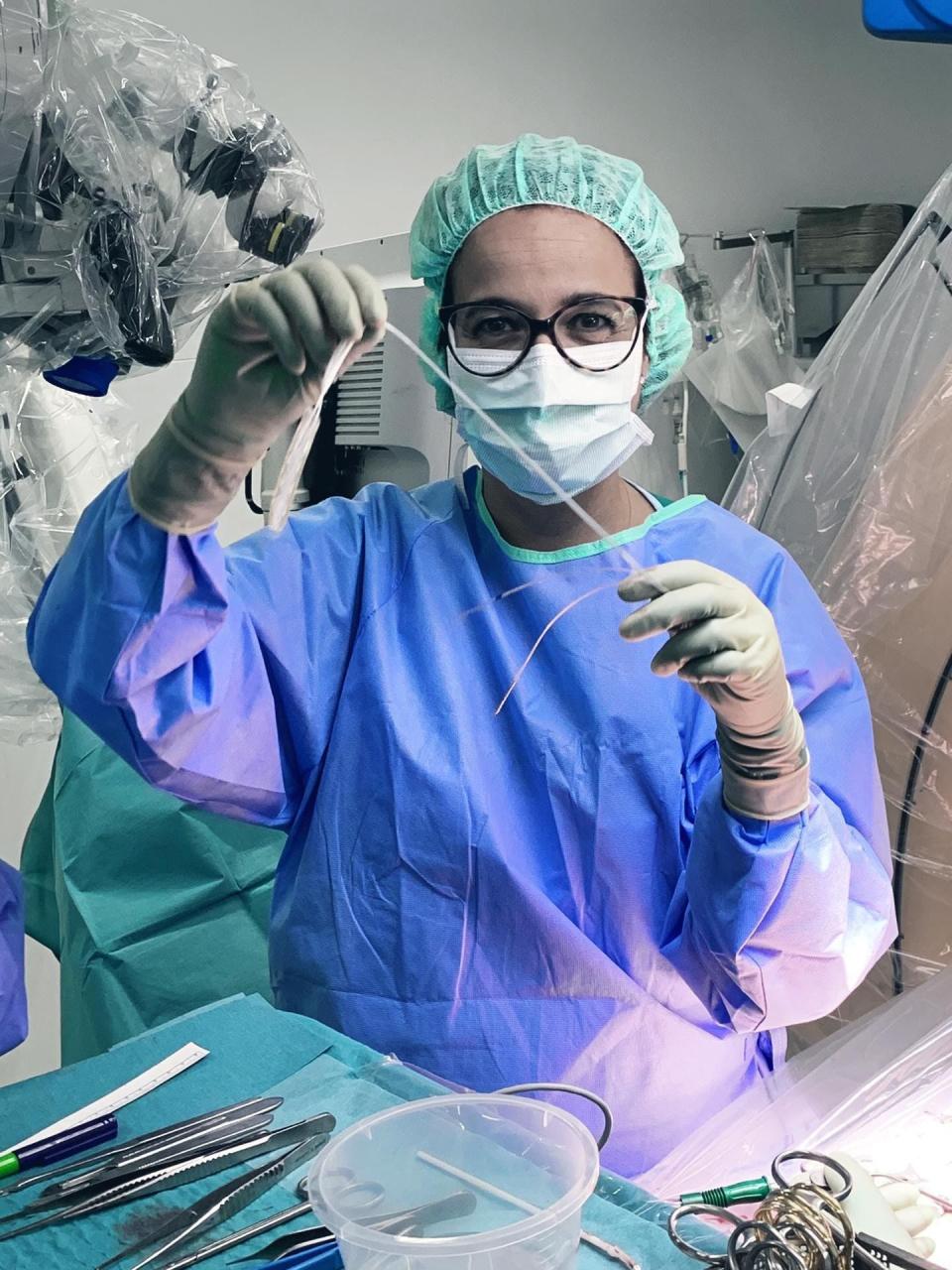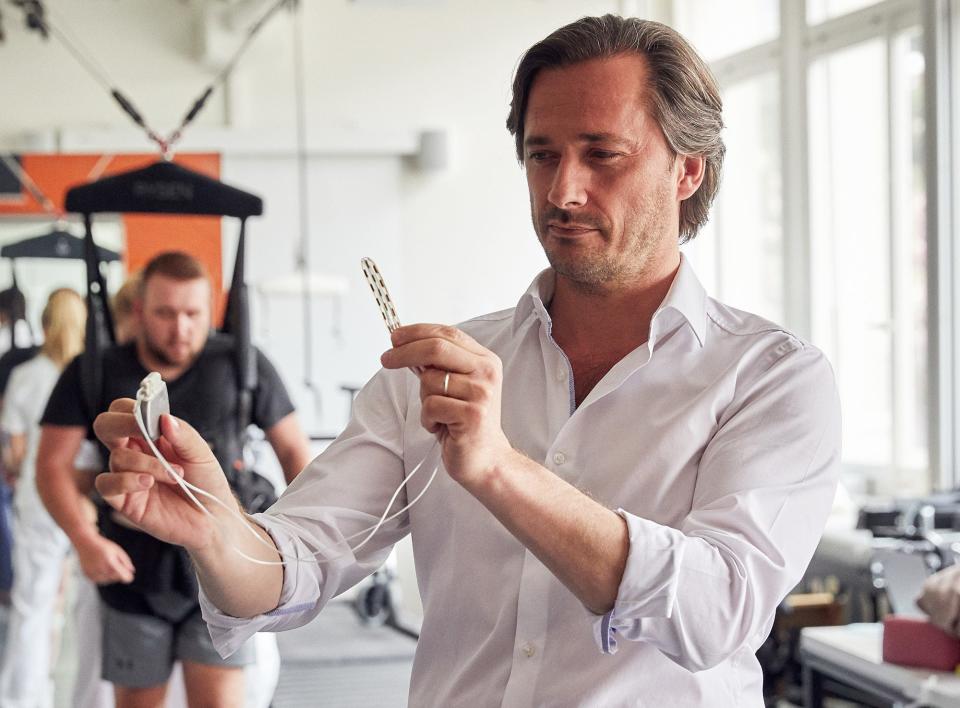Paralyzed patients walking in minutes: New electrode device a step forward in spinal injury care
- Oops!Something went wrong.Please try again later.
For years, researchers have been helping paralyzed people walk by stimulating their spinal cords. Now, a team of Swiss scientists has improved upon that effort, enabling three patients with spinal cord injuries to turn on a device and take their first steps within minutes.
The improvements suggest that a commercial product, available to tens of thousands of paralyzed people worldwide, might only be a few years away.
One of the men, Michel Roccati, 29, who was injured in a 2017 motorbike accident, said with the stimulation turned on he can now walk, bike, swim and climb stairs. "Everything I have in mind to train, I can do with the stimulation," he said on a recent call with media.
He uses the stimulator, which activates electrodes implanted on his spinal column, a few hours a day. "It's part of my daily life," he said.
The device was designed specifically for this use in contrast to previous devices, which were repurposed neurostimulators meant to help people with Parkinson's and similar diseases.

While the stimulation had an effect right away, it still took three to four months of training before Roccati and the others could walk without support.
"It's not that it's a miracle right away," said Grégoire Courtine of the Swiss Federal Institute of Technology, who is helping to lead the work published Monday in Nature Medicine. But the stimulation enabled Roccati to begin training about 10 days after his August 2020 surgery.
"After one day I was able to walk," Roccati said. "To see my legs moving, it was a very emotional experience."
He stayed in Switzerland for nine months of rehabilitation before moving home to Torino, Italy where he continues his therapy. "I feel better when I use it," said Roccati, who now lives independently in his own apartment. "I can do everything alone, no problem."
Roccati and the other two trial participants had no sensations or movements in their legs at the beginning of the trial.
Although more work needs to be done to refine the stimulator, Dr. Jocelyne Bloch, a neuroscientist and neurosurgeon who helped lead the work at Lausanne University Hospital, said she expects it will be widely effective for spinal cord injuries.
"We need one day to have this technology as a treatment available for everyone," she said. "It's not yet, but hopefully will be within a few years."
The Swiss team, collaborating with a company called Onward Medical where Courtine is the chief science officer, is also using a similar approach to address other problems that often accompany paralysis, including high blood pressure and lack of bowel control and sexual function, as well as severe Parkinson's Disease.
"We believe there is a bright future for stimulation technology," Courtine said.
The idea of using a stimulator isn't brand new, said Dr. Daniel Lu, a neurosurgeon at UCLA Health in Los Angeles, where scientists have been using stimulators on paralyzed patients for a decade. But the Swiss team's work is "exciting in the sense that it is moving more toward reality."
The technology still needs to be tested on many more patients before it is ready for widespread use, Lu said, and studies need to involve controls who do not receive active stimulation.
Even if it works well, patients will not ever be restored to precisely where they were before their injury, he said. "I'm worried patients will say, 'I can be normal,'" Lu said. But when people train consistently while receiving stimulation, he's seen dramatic improvements in function.

Spinal cord patients, he said are probably more interested in improving bladder, bowel and hand function than in being able to walk again. "A wheelchair does a pretty good job of getting you from point A to point B," he said. Surveys suggest patients would rather be able to control their bodily functions, so they can resume interacting in the world.
Improvements in hand and arm control are further away, he said. But there's no question that addressing paralysis will have far-reaching medical benefits, Lu said.
"If you can cure spinal cord injuries, you can probably cure stroke," he said, along with neurodegenerative diseases. "This is important for everyone. For humanity."
Improving technology
The surgery and device are not appropriate for everyone with paralysis. The team has focused on the trunk and legs, so people without use of their arms or hands would not benefit.
Studies in mice also suggest the device will work better in younger people than older ones, though the team has so far shown effective results in people as old as 50. People with less severe lesions recovered more fully, Bloch said.

For this trial, the team chose three men who were stable and whose spinal cord injuries occurred more than a year ago. Most improvement after spinal cord injury occurs in the first year, so improvements after that point are likely to come from medical interventions rather than hard work or natural recovery.
Bloch said she was originally concerned that patients might find the stimulation painful, but no one has complained.
Roccati carries a tablet with him and can program the device to allow him different activities.
The researchers' next step will be to simplify the device and implant a tiny computer along with the electrodes so the stimulation can be turned easily on and off from a cellphone, Courtine said.
"It's very important that the technology is very easy to use and immediately effective," Courtine said.
The stimulation will eventually be used by people much sooner after their injuries, when the benefits are likely to be even larger, Bloch said.
Because every patient's injury is slightly different, Courtine said he envisions having a library of electrode array options that a surgeon can choose from.
People also recover and respond differently to the electrodes, in part because of the extent of their injuries and in part because of their motivation, he said. "It's difficult to anticipate the range of improvement we will observe in the future," he said.
The team hopes within a few years to begin a 50-100 patient trial to validate the technology, and eventually, a 1,000-person trial to earn the approval of the Food and Drug Administration.
"We have not yet developed the full extent of this technology," Courtine said. "We expect even better recovery."
Contact Karen Weintraub at kweintraub@usatoday.com
Health and patient safety coverage at USA TODAY is made possible in part by a grant from the Masimo Foundation for Ethics, Innovation and Competition in Healthcare. The Masimo Foundation does not provide editorial input.
This article originally appeared on USA TODAY: New electrode stimulator makes strides in spinal cord injury treatment

